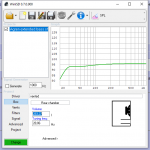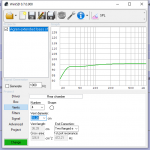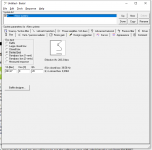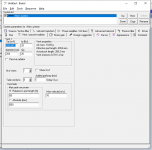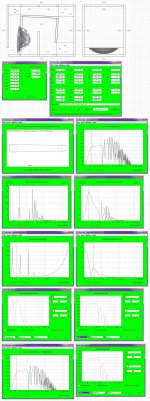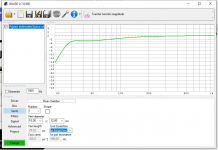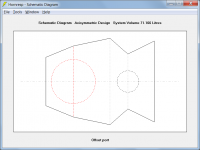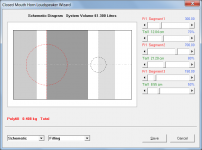Not sure what version of WinISD you are using, but my old copy tells me that for a box volume of 283 litres, a tuning frequency of 28 Hz and a port area of 327 square cm, the vent length should be 28.5 cm, not 36.4 cm.
In Hornresp, for Ang = 2 x Pi, Vrc = 283, Ap = 327 and Lpt = 28.5, the Helmholtz resonance frequency is 28.0 Hz - exactly the same as for WinISD.
Then the current version of WinISD is buggy.
Attachments
Then the current version of WinISD is buggy.
Anyone knows how to contact Juha Hartikainen?
Have you tried modeling a negative flare tapped horn. I'm thinking you can get better performance within that same 283 liters. In their simplest form, a TH has 7 boards just like a BR. And, the T-TQWT will sound better!
I have not tried. I believe my friend likes the visual impact of the woofer. He is building a three way with a 10 inch mid and a horn.
This is his first speaker project in 40 years, the previous being a RT 70/80 horn. He will not listen to me if I start talking about horns 🙂
Not sure what version of WinISD you are using, but my old copy tells me that for a box volume of 283 litres, a tuning frequency of 28 Hz and a port area of 327 square cm, the vent length should be 28.5 cm, not 36.4 cm.
In Hornresp, for Ang = 2 x Pi, Vrc = 283, Ap = 327 and Lpt = 28.5, the Helmholtz resonance frequency is 28.0 Hz - exactly the same as for WinISD.
I simulated in Basta! as well. Same result as Hornresp, give or take a cm port length or a hertz in helmholz resonance.
Attachments
Group delay is sketchy on a tapped horn.
5.7258 msec at 79.55 hz.
Attachments
Last edited:
Then the current version of WinISD is buggy.
Try specifying 1 port tube rather than 4, and only one end flanged.
(Don't forget to adjust the vent diameter accordingly).
Last edited:
Hi Mårten,
The offset driver / port configuration shown in your diagram cannot be simulated using Hornresp.
Kind regards,
David
If you implement offset driver with stubbed horn it can be done. I know you will not implement this but at least I have to try 😀
Then the current version of WinISD is buggy.
WinISD has been buggy for quite some time.
It's a nice program. It's just not exactly accurate enough for serious work. Ok for people that are not really measuring or want to optimize their enclosures.
Try specifying 1 port tube rather than 4, and only one end flanged.
(Don't forget to adjust the vent diameter accordingly).
Thanks David! Always so helpful.
Changing end correction has no effect. You are right. The tube length shortens.
Is this a bug or is there something I need to study?
Attachments
If you implement offset driver with stubbed horn it can be done. I know you will not implement this but at least I have to try 😀
Even though the amount of work involved to fully integrate the feature is massive, I decided nevertheless shortly after your original Post #10428 to proceed anyway, but not in the manner that you have suggested above. I have been working on the code for the past month, and still have some way to go. It will be possible to specify an enclosure with an offset driver together with either an offset port tube or an offset passive radiator, as shown in the attached example (for an offset port).
Attachments
Changing end correction has no effect. You are right. The tube length shortens.
Hi Mårten,
For a given enclosure volume and port tube cross-sectional area and length, changing from both ends flanged to one end flanged and the other end unflanged should increase the Helmholtz resonance frequency slightly. Changing from 4 tubes to one tube having the same total area will also affect the tuning frequency, due to the different loading conditions at the ends of the tube/s.
For a bass-reflex loudspeaker, Hornresp assumes a single port tube with the radiating end flanged and the internal end unflanged (this is different to how it is shown in the schematic diagram).
Kind regards,
David
It will be possible to specify an enclosure with an offset driver together with either an offset port tube or an offset passive radiator
I forgot to mention that it will also be possible to specify absorbent filling material in the enclosure.
Attachments
Even though the amount of work involved to fully integrate the feature is massive, I decided nevertheless shortly after your original Post #10428 to proceed anyway, but not in the manner that you have suggested above. I have been working on the code for the past month, and still have some way to go. It will be possible to specify an enclosure with an offset driver together with either an offset port tube or an offset passive radiator, as shown in the attached example (for an offset port).
Thank you so much David! This feature will be very useful. And the absorbent feature as well.
While you are at it, why not also allow a stub? 😀
Even though the amount of work involved to fully integrate the feature is massive, I decided nevertheless shortly after your original Post #10428 to proceed anyway, but not in the manner that you have suggested above. I have been working on the code for the past month, and still have some way to go. It will be possible to specify an enclosure with an offset driver together with either an offset port tube or an offset passive radiator, as shown in the attached example (for an offset port).
Please delete this post David. I don't want to be remembered for being responsible for introducing proper simulation of BR into Hornresp

Hi Mårten,
For a given enclosure volume and port tube cross-sectional area and length, changing from both ends flanged to one end flanged and the other end unflanged should increase the Helmholtz resonance frequency slightly. Changing from 4 tubes to one tube having the same total area will also affect the tuning frequency, due to the different loading conditions at the ends of the tube/s.
For a bass-reflex loudspeaker, Hornresp assumes a single port tube with the radiating end flanged and the internal end unflanged (this is different to how it is shown in the schematic diagram).
Kind regards,
David
Thanks David!
Going from 28 cm (one tube) to 36 cm (four tubes) is reasonable?
I exported a cpl of IR's to REW, the response is different...whats this mean?
What I find interesting is that the difference in levels between the 2 IR's changed.
What I find interesting is that the difference in levels between the 2 IR's changed.
Going from 28 cm (one tube) to 36 cm (four tubes) is reasonable?
Assuming that WinISD is correct, then yes 🙂.
Hi all,
need some help on how to model...
... a driver mounted in a sealed box, with a plate completely covering the face of the driver, and with a hole in the plate.
Plate thickness, or length of hole could range fro 1mm to 15mm.
Basically, like placing a driver in a MEH, but without any horn.
I'm thinking it might be worthwhile to understand how this simple test bed models, to learn what compression ratios, hole lengths, and T/S parameters work best...for eventual placement in a MEH.
Oh, and if there is a way to model changing the volume of space between the driver cone and the plate, that would be helpful too.
Thanks, mark
need some help on how to model...
... a driver mounted in a sealed box, with a plate completely covering the face of the driver, and with a hole in the plate.
Plate thickness, or length of hole could range fro 1mm to 15mm.
Basically, like placing a driver in a MEH, but without any horn.
I'm thinking it might be worthwhile to understand how this simple test bed models, to learn what compression ratios, hole lengths, and T/S parameters work best...for eventual placement in a MEH.
Oh, and if there is a way to model changing the volume of space between the driver cone and the plate, that would be helpful too.
Thanks, mark
- Home
- Loudspeakers
- Subwoofers
- Hornresp
